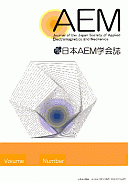Volume 25, Issue 4
Displaying 1-8 of 8 articles from this issue
- |<
- <
- 1
- >
- >|
Special Topic: Automotive Engineering
-
2017 Volume 25 Issue 4 Pages 361-364
Published: 2017
Released on J-STAGE: January 30, 2018
Download PDF (668K) -
2017 Volume 25 Issue 4 Pages 365-372
Published: 2017
Released on J-STAGE: January 30, 2018
Download PDF (4382K) -
2017 Volume 25 Issue 4 Pages 373-378
Published: 2017
Released on J-STAGE: January 30, 2018
Download PDF (6016K) -
2017 Volume 25 Issue 4 Pages 379-382
Published: 2017
Released on J-STAGE: January 30, 2018
Download PDF (5926K) -
2017 Volume 25 Issue 4 Pages 383-389
Published: 2017
Released on J-STAGE: January 30, 2018
Download PDF (2207K) -
2017 Volume 25 Issue 4 Pages 390-394
Published: 2017
Released on J-STAGE: January 30, 2018
Download PDF (3501K)
Regular Papers
-
2017 Volume 25 Issue 4 Pages 395-402
Published: 2017
Released on J-STAGE: January 30, 2018
Download PDF (1801K) -
2017 Volume 25 Issue 4 Pages 403-408
Published: 2017
Released on J-STAGE: January 30, 2018
Download PDF (2973K)
- |<
- <
- 1
- >
- >|
